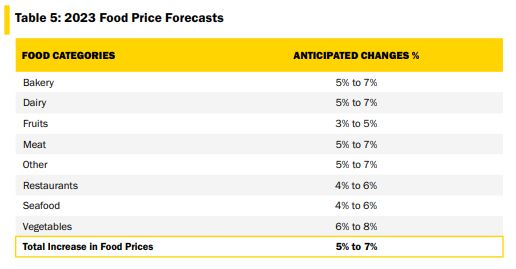Halifax, NS – Consumers can expect food prices to continue to rise. Canada’s Food Price Report 2023 predicts a 5 percent to 7 percent food price increase in 2023, with the most substantial increases in vegetables, dairy, and meat.
The report forecasts that an average family of four, including a man (age 31-50), woman (age 31-50), boy (age 14-18), and girl (age 9-13) will spend up to $16,288.41 per year on food, an increase of up to $1,065.60 from what was observed in 2022.
“To say that it’s been a challenging year for Canadians at the grocery store would be an understatement,” says Dr. Sylvain Charlebois, project lead and Director of the Agri-Food Analytics Lab at Dalhousie University. “Consumers will continue to get smarter about grocery shopping as they navigate through this so-called food inflation storm.”
Canada’s Food Price Report is an annual collaboration between research partners Dalhousie University, the University of Guelph, the University of Saskatchewan and the University of British Columbia. This cross-country research team uses historical data sources, machine learning algorithms and predictive analytics tools developed over many years to make predictions about Canadian food prices.
A new forecasting model was used for the 2023 report. “It includes historical data plus the additional variables of forecasted inflation and Canadian-US exchange rate,” says Dr. Kelleen Wiseman, UBC campus lead. “This resulted in a rebalance between past data and future forecasts. Forecasting food prices is challenging!”
Click to download a copy of the Canadian Food Price Report.

“Each year, the Canadian Food Price Report provides consumers with important information on how the coming year might affect them in terms of food prices and affordability,” says Andrea Rankin, the Master of Public Administration candidate at Dalhousie University who worked on the 2023 report. “It also gives important context for why prices are changing. Climate change, supply change disruptions, carbon taxes, geopolitical climates, and rising transportation costs are all contributing factors.”
International events continue to affect food prices at home. “The uncertainty from the ongoing Ukraine war shows no signs of ceasing and the Canadian dollar compared to the US dollar has recently ranged five to seven cents lower and this has driven up the cost of all imported American products” says Dr. Stuart Smyth, University of Saskatchewan campus lead. “Labour shortages in key sectors, such as crop harvesting, food processing, and transportation lower supply and drive-up prices.”
What can a concerned consumer do? Now is the time to become a “smart shopper” by consulting flyers for specials, creating and sticking to a budget and shopping list, looking for substitutes for expensive foods (such as frozen fruits and vegetables instead of fresh, and plant-based proteins like chickpeas or lentils instead of meat), or freezing meat when it comes on sale.
“We haven’t seen food prices increase this high in Canada for over 40 years and based on our findings, the increases we have predicted are still quite high but not as high as the increases for 2022,” says Dr. Simon Somogyi, University of Guelph campus lead. “That may be cold comfort for Canadians, as food prices are already high, but if inflation can come down, it’s possible that we could see price increases for 2023 at or below 5 percent.”